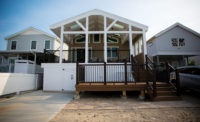Finding a Better Way to Do Good
A New Orleans firm rethinks the way it does pro bono work.

POP-UP ART For the Arts Council of New Orleans, employees at Eskew+Dumez+Ripple designed temporary art galleries, such as the one above, that would fit into open spaces on existing properties
Rendering courtesy Eskew+Dumez+Ripple
Sometimes good intentions need proper structure—a process, as architects like to say. This was clearly the case for Eskew+Dumez+Ripple (EDR), the award-winning New Orleans firm that has played a key role in the post-Katrina revival of the Crescent City. Until recently, EDR’s approach to pro bono work was loose and informal, but as the firm grew in recent years, that became unwieldy and ultimately unsatisfying. “We’d done extensive pro bono work in the past, but without focus,” says Jose Alvarez, a principal at EDR. As a result, those efforts seemed to dissipate quickly. “We were looking to create stronger community bonds and more meaningful results,” he adds.
Out of that desire to connect was born the firm’s MLK Day of Service program. Held for the first time in January 2015 on Martin Luther King Jr. Day, the idea—originally hatched by Alvarez—combines the firm’s annual research fellowship with a firm-wide day of service. (In 2015 its theme was community engagement.) As a first step, EDR’s research fellow and event organizer Nicole Joslin sent out RFP’s to community groups citywide in need of design services. Ten proposals were reviewed by an internal committee of the firm, which narrowed the list to eight. “We gave a presentation to the full staff of the eight, and then asked them to vote on their first and second choices,” says Sabeen Hasan, a project architect and member of the selection committee. The top four finishers were chosen to participate in the program.
Everyone in the firm took part, devoting the entire day to a charrette with one of the community groups. There was one strategic stipulation: no principals or associates could be team leaders. “We wanted them to take a backseat and act as mentors and guides,” Hasan says, “so that the younger staff could take lead roles in moving these projects forward.” In the weeks leading up to the event, those team captains became the primary source of contact for the community organizations, responsible for further defining the scope of the work, the approach of the larger group on the actual day of service, and the inevitable follow-up that insured successful completion of the projects.
All four community groups had needs that could be met through some kind of design intervention, whether it was help in rehabilitating blighted houses (Youth Rebuilding New Orleans), design and construction of temporary art galleries (the Arts Council of New Orleans), or a wayfinding and signage system for a new food market (ReFresh Coalition).
But the power of a properly staged brainstorming session can uncover some hidden needs. For example, Live Oaks Wilderness Camp—an organization that identifies a diverse group of future leaders, ages 10 to 12, and brings them together for 10 days in the summer—wanted flexible, low-cost structures for a temporary camp. ERD delivered these structures, but the camp also received something else that was indispensable: a way to tell its story. An EDR-produced video on Live Oaks helped jumpstart the organization’s fundraising, which allowed it to fully book the camp and rent the land. “Had we not had that video,” says Jack Carey, a vice president of Teach For America, which founded Live Oaks, “I don’t know what I would have done, standing in front of a room full of potential donors.” EDR hopes to create ongoing relationships with all of the groups, providing additional professional services, for example, to Live Oaks as they take steps to build a permanent camp.
In addition to supporting the professional development for younger staff at EDR, the day of service is an organic way to establish deeper roots in the community. The potential impact could mean ongoing relationships with as many as 20 community organizations, a crucial outreach tool for a firm that has been transformed in the years following Katrina. “Before the storm, we were primarily a firm of Louisiana-born, Louisiana-educated designers,” says Steve Dumez, principal and design director, who credits Public Architecture, the national nonprofit organization founded in 2002, for its role in inspiring the day of service. “Most of the staff we hired after Katrina were people who made a decision to come to New Orleans. They were young, idealistic professionals who wanted to make a difference.”
All of them will get another chance next month, when a second MLK Day of Service is planned, on the theme of health and wellness. The firm intends to post a comprehensive guidebook for the program, in the hopes that other firms might adapt it to their own communities.




